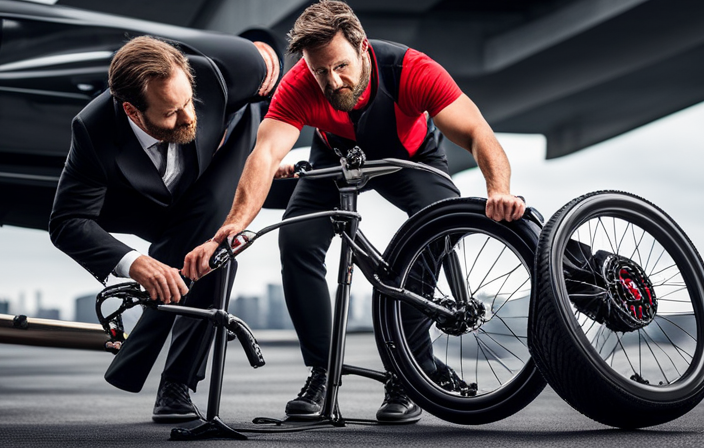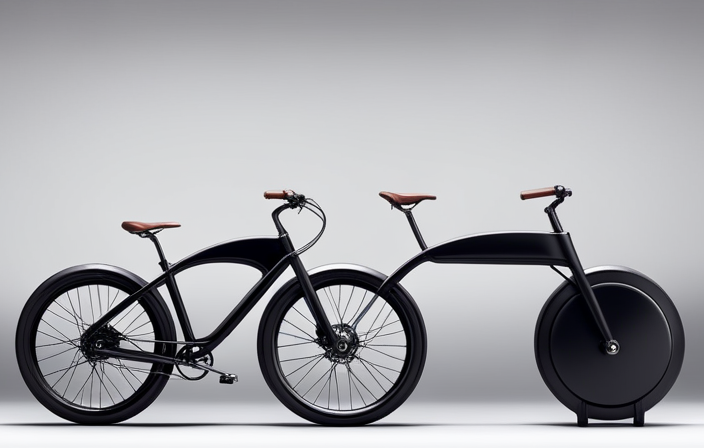Being a passionate cyclist, I’ve always wondered about how much electric bikes really cost. There seems to be a variety of views on this subject. Therefore, I decided to conduct some research to discover the facts.
In this article, I’ll explore the various factors that influence electric bike prices, from the type of bike to financing options. Whether you’re looking for an entry-level option or a high-end model, we’ll break down the costs and help you make an informed decision.
Key Takeaways
- Electric bikes can be financed through manufacturer financing, credit cards, personal loans, or peer-to-peer lending platforms.
- DIY electric bike conversion kits offer a cost-effective alternative to pre-made electric bikes.
- Pre-made electric bikes can range from $1,500 to $4,000, while conversion kits may be more budget-friendly.
- Conversion kits allow for customization and control over components, but may require technical know-how and may not match the performance and warranty of pre-made options.
Different Types of Electric Bikes
There’s a wide range of electric bikes available, each offering different features and price points. Electric bikes come in various types, including city bikes, mountain bikes, folding bikes, and fat tire bikes.
City bikes are designed for urban commuting and have a sleek and lightweight frame. Mountain bikes, on the other hand, are built for off-road adventures with their sturdy construction and powerful motors. Folding bikes are perfect for those with limited storage space, as they can be easily folded and stored away. Lastly, fat tire bikes are designed to tackle any terrain with their wide tires that provide excellent stability and traction.
These different types of electric bikes come at different price ranges, depending on factors such as the brand, motor power, battery capacity, and additional features. Transitioning into the next section, the price of electric bikes can be influenced by various factors, so let’s dive into those.
Factors Influencing Electric Bike Prices
One of the factors that influence the prices of e-bikes is their features. Electric bikes come with a variety of features that can significantly impact their cost. For example, some high-end electric bikes may have advanced features like a powerful motor, long battery life, and high-quality components, which can drive up the price.
Additionally, the type of battery used, such as lithium-ion or lead-acid, can also affect the cost. Another factor that influences the price is the brand reputation and popularity of the electric bike manufacturer. Well-known brands often charge a premium for their products. Furthermore, the level of customer service and warranty provided by the manufacturer can also contribute to the overall price.
Considering these factors, it is important to understand the features and reputation of different electric bike models before making a purchase. This leads us to the next section about entry-level electric bikes, which offer a more affordable option for those on a budget.
Entry-Level Electric Bikes
When considering entry-level electric bikes, it’s important to look at the price range, features, and specifications.
The price range for these bikes can vary greatly, starting from around $500 and going up to $2,000 or more.
Features such as battery capacity, motor power, and range are key factors to consider, along with specifications like frame material and weight.
Price Range
Electric bikes can range in price from a few hundred dollars to several thousand dollars. When considering the price of an electric bike, it’s important to understand that there are different levels of quality and features that contribute to the overall cost. Here are three price ranges to give you an idea of what to expect:
-
Budget-friendly options: These electric bikes typically fall in the $500 to $1,000 range. While they may not have all the bells and whistles of higher-end models, they still provide a reliable and enjoyable riding experience.
-
Mid-range options: In the $1,000 to $2,500 range, you can find electric bikes with better components, longer battery life, and more advanced features. They offer a good balance between affordability and performance.
-
High-end options: If you’re willing to invest more, electric bikes priced above $2,500 offer top-of-the-line features, high-quality materials, and superior performance. These bikes are designed for serious riders who demand the best.
When considering an electric bike, price is just one factor to consider. Now let’s delve into the features and specifications that make each bike unique.
Features and Specifications
To understand the unique features and specifications of electric bikes, you should consider the different levels of quality and performance.
Electric bikes come with a variety of features that cater to different needs and preferences. Some bikes offer powerful motors that can reach higher speeds, while others prioritize longer battery life for extended rides. Additionally, electric bikes may have different levels of pedal assist, allowing riders to choose the amount of assistance they want while pedaling. Other features include different frame styles, suspension systems, and braking mechanisms. These specifications determine the overall performance and comfort of the bike.
Moving on to mid-range electric bikes, they offer a balance between affordability and quality, making them a popular choice for many riders.
Mid-Range Electric Bikes
You can find mid-range electric bikes at reasonable prices. These bikes offer a great balance between affordability and quality, making them a popular choice for many riders.
Here are three reasons why mid-range electric bikes are a fantastic option:
-
Affordability: Mid-range electric bikes are priced reasonably, making them accessible to a wide range of budgets. You don’t have to break the bank to enjoy the benefits of an electric bike.
-
Quality Components: Despite their lower price tag, mid-range electric bikes are equipped with reliable and durable components. You can expect decent battery life, a comfortable ride, and responsive brakes.
-
Versatility: Mid-range electric bikes come in various styles and designs, catering to different riding preferences. Whether you’re commuting to work, exploring trails, or running errands, there’s a mid-range electric bike that suits your needs.
Now, let’s move on to the next section and delve into the world of high-end electric bikes.
High-End Electric Bikes
High-end e-bikes offer top-of-the-line features and performance, making them a coveted choice among avid cyclists. These electric bikes come with powerful motors and long-lasting batteries, allowing riders to conquer steep hills and go on longer rides without worrying about running out of power.
The frames of high-end e-bikes are often made from lightweight and durable materials like carbon fiber, enhancing the overall riding experience. Additionally, these bikes are equipped with advanced suspension systems and high-quality components, ensuring a smooth and comfortable ride.
However, it’s important to note that high-end electric bikes often come with a hefty price tag, ranging from $3,000 to $10,000 or more. For those looking for a more budget-friendly option, used electric bikes can be a great alternative.
Used Electric Bikes
When it comes to used electric bikes, there are both pros and cons to consider.
On the positive side, buying a used electric bike can save you a significant amount of money compared to purchasing a new one.
However, it’s important to be cautious and thoroughly inspect the bike before making a purchase to avoid any potential issues.
As for where to find used electric bikes, you can check online marketplaces such as Craigslist or eBay, local classified ads, or even ask around in your community for any available options.
Pros and Cons
One of the cons of electric bikes is that they can be quite expensive. However, there are several pros to consider as well.
One advantage of buying a used electric bike is that it can save you a significant amount of money compared to buying a new one. Many people sell their electric bikes after only a few years of use, so you can often find a well-maintained bike for a fraction of the original price.
Another advantage is that you can find a wider variety of models and brands when looking for a used electric bike. This allows you to choose a bike that suits your specific needs and preferences.
If you’re wondering where to find them, there are numerous online platforms and classified ads where you can search for used electric bikes.
Where to Find Them
You can easily find used electric bikes on various online platforms and classified ads. Websites like Craigslist, eBay, and Facebook Marketplace are popular options for finding a wide range of electric bikes at different price points. These platforms allow you to filter your search based on location, price, and specific bike features, making it convenient to find the perfect electric bike for your needs.
Additionally, local bike shops and specialty electric bike stores may also have used electric bikes available for purchase. It’s worth checking these places as well, as they often offer expert advice and support.
Once you’ve found the right electric bike, you can explore financing options to make your purchase more affordable.
Financing Options
If you’re looking for financing options, there are several ways to pay for an electric bike. Here are some options to consider:
-
Manufacturer Financing: Many electric bike companies offer financing options directly through their websites or in partnership with third-party lenders. This allows you to make monthly payments instead of paying the full amount upfront.
-
Credit Cards: Using a credit card to purchase an electric bike can be a convenient option. Some credit cards even offer promotional financing with low or zero interest rates for a certain period.
-
Personal Loans: Taking out a personal loan from a bank or online lender is another option. This allows you to borrow a specific amount of money and repay it over time with fixed monthly payments.
-
Peer-to-Peer Lending: Online platforms connect borrowers with individuals willing to lend money. Peer-to-peer lending can be a good option if you’re looking for competitive interest rates and flexible repayment terms.
If financing isn’t for you, the next section will discuss DIY electric bike conversion kits and how to transform your regular bike into an electric one.
DIY Electric Bike Conversion Kits
When considering electric bikes, it’s important to explore all the options available.
One option is to convert a regular bike into an electric one using a conversion kit.
One key point to consider is the cost comparison between pre-made electric bikes and conversion kits.
Additionally, it’s important to weigh the pros and cons of using conversion kits.
For example, one pro is the ability to customize your own bike.
However, there may be potential challenges with installation and maintenance.
Cost Comparison to Pre-Made Electric Bikes
To compare costs, check out how much pre-made electric bikes typically cost. Below is a table that shows a cost comparison between pre-made electric bikes and DIY electric bike conversion kits.
| Pre-Made Electric Bikes | Cost |
|---|---|
| Standard Model | $1,500 |
| Mid-Range Model | $2,500 |
| High-End Model | $4,000 |
As you can see, pre-made electric bikes can range from $1,500 to $4,000 depending on the model and brand. While this may seem more expensive compared to conversion kits, it is important to consider the convenience and quality that come with pre-made options. Pre-made electric bikes often have better components and warranties, ensuring a more reliable and enjoyable riding experience. However, if you are on a tight budget or enjoy the process of building your own bike, a conversion kit may be a more cost-effective option. Now, let’s discuss the pros and cons of conversion kits.
Pros and Cons of Conversion Kits
Now that we’ve compared the cost of pre-made electric bikes, let’s take a closer look at the pros and cons of conversion kits.
Personally, I find conversion kits to be a fascinating option for turning a regular bike into an electric one. One major advantage is that they are often more affordable than buying a brand new electric bike. Plus, it allows you to choose the specific components you want, giving you more control over the final product.
However, there are a few downsides to consider. Conversion kits can be a bit more complicated to install, requiring some technical know-how. Additionally, they may not offer the same level of performance or warranty as a pre-made electric bike.
Nonetheless, they can still be a great option for those who want to save some money and enjoy the process of customizing their own electric bike.
Speaking of costs, let’s now delve into the maintenance and upkeep expenses.
Maintenance and Upkeep Costs
When it comes to the maintenance and upkeep costs of an electric bike, there are a few key points to consider.
First, battery replacement is an important factor to keep in mind. Over time, the battery will wear out and need to be replaced, which can be a significant expense.
Second, regular maintenance is necessary to keep the bike in good working condition and prevent any major issues from arising. This includes tasks such as tire inflation, chain lubrication, and brake adjustments.
Lastly, repairs may be needed from time to time, whether it’s fixing a flat tire or addressing a more complex issue. These costs can vary depending on the specific problem, but it’s important to factor them into the overall cost of owning an electric bike.
Battery Replacement
The cost of electric bike battery replacement can vary depending on the brand and model. Generally, a new battery can range from $200 to $800.
Higher-end electric bikes tend to have more expensive batteries, while budget-friendly options may have more affordable replacements.
It’s important to consider the lifespan of the battery when calculating the overall cost of owning an electric bike. On average, a lithium-ion battery for an electric bike can last around 2 to 4 years before it needs to be replaced.
Regular maintenance, such as keeping the battery charged and storing it properly, can help prolong its lifespan. Additionally, some manufacturers offer warranties or battery recycling programs, which can help offset the cost of replacement.
Regular Maintenance
Regular maintenance for an e-bike includes keeping the battery charged and storing it properly to help extend its lifespan. I make sure to charge my e-bike’s battery after every ride, as it is essential for its performance. It’s important to follow the manufacturer’s instructions on charging time and avoid overcharging.
Additionally, storing the battery in a cool and dry place when not in use prevents any damage due to extreme temperatures or moisture. Besides the battery, regular maintenance also involves checking the brakes, tires, and gears. I inspect the brake pads for wear and tear, ensure the tires are properly inflated, and lubricate the gears to keep them running smoothly.
By taking care of these routine tasks, I can enjoy my e-bike for a long time without any major issues. Speaking of repairs, let’s move on to the next section.
Repairs
Maintaining an e-bike includes periodically checking for and addressing any necessary repairs. As an electric bike owner, I understand the importance of keeping my bike in good working order.
When it comes to repairs, there are a few key areas that may require attention:
-
Battery Issues: Over time, the battery may lose its capacity or develop charging problems. It’s crucial to monitor the battery’s performance and address any issues promptly.
-
Motor Malfunctions: The motor is the heart of an electric bike, and any malfunctions can significantly impact its performance. Regular inspections and prompt repairs can help ensure its longevity.
-
Brake Problems: Like any bicycle, e-bikes rely on brakes to ensure safety. Regularly checking and adjusting the brakes is essential for optimal performance.
-
Wiring and Electronics: E-bikes have complex wiring systems and electronic components that may require repairs or replacements over time. Regular inspections can help identify any potential issues.
By addressing these repairs promptly, I can enjoy a smooth and safe riding experience with my electric bike.
Frequently Asked Questions
Are electric bikes legal to use on public roads and bike paths?
Yes, electric bikes are legal to use on public roads and bike paths. They provide an eco-friendly mode of transportation, allowing riders to easily navigate through traffic and enjoy the outdoors.
How far can an electric bike travel on a single charge?
How far can an electric bike travel on a single charge? Imagine effortlessly cruising through scenic landscapes for up to 50 miles without breaking a sweat. Electric bikes offer an incredible range and allow you to explore further than ever before.
Do electric bikes require a special license or registration?
No, electric bikes do not require a special license or registration. They are considered bicycles and can be ridden just like any other bicycle.
Can electric bikes be used in rainy or snowy conditions?
Electric bikes can be used in rainy or snowy conditions, making them versatile for all weather. Their built-in weatherproof features ensure a safe and enjoyable ride, without the need to worry about getting wet or slipping on icy roads.
What is the average lifespan of an electric bike battery?
The average lifespan of an electric bike battery can vary depending on factors like usage and maintenance. Generally, they can last anywhere from 2 to 5 years before needing to be replaced.
Conclusion
In conclusion, electric bikes come in a wide range of prices, depending on various factors such as the type, brand, and features.
While entry-level bikes can be affordable, mid-range and high-end options can be pricier.
However, just like a bee buzzing in a field of flowers, the investment in an electric bike can bring joy and freedom to your daily commute or weekend adventures.
So, don’t let the cost deter you from experiencing the exhilaration of riding an electric bike.









